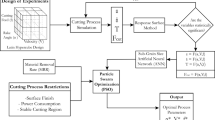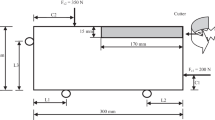Abstract
This work aims to improve the surface quality of commercially pure titanium (CP-Ti) with free alumina lapping fluid and establish the relationship between the main process parameters of lapping and roughness. On this basis, the optimal process parameters were searched by performing particle swarm optimization with mutation. First, free alumina lapping fluid was used to perform an L9(33) orthogonal experiment on CP-Ti to acquire data samples to train the neural network. At the same time, a BP neural network was created to fit the nonlinear functional relation among the lapping pressure P, spindle speed n, slurry flow Q and roughness Ra. Then, the range of the neuron numbers in the hidden layer of the neural network was determined by empirical formulas and the Kolmogorov theorem. On this basis, particle swarm optimization with mutation was used to search for the optimal process parameter configurations for lapping CP-Ti. The optimal process parameter configurations were used in the neural network to calculate the prediction value. Finally, the accuracy of the prediction was verified experimentally. The optimum process parameter configurations found by particle swarm optimization were as follows: the lapping pressure was 5 kPa, spindle speed was 60 r·min−1 and slurry flow was 50 ml·min−1. Then, the configurations were applied to a neural network to simulate prediction: the roughness was 0.1127 μm. The roughness obtained by experiments was 0.1134 μm. The error was 0.62%, which indicates that the well-trained neural network can achieve a good prediction when experimental data are missing. Applying the particle swarm optimization (PSO) algorithm with mutation to a neural network will obtain the optimal process parameter configurations, which can effectively improve the surface quality of CP-Ti lapped with free abrasive.





Similar content being viewed by others

Data Availability
The datasets used or analysed during the current study are available from the corresponding author on reasonable request.
References
Chen WQ, Zhang SM, Qiu J (2020) Surface analysis and corrosion behavior of pure titanium under fluoride exposure. J Prosthet Dent 124(2):239
Shoichi K, Akira U, Hiroyuki A (2020) Combined effects of low temperature nitriding and cold rolling on fatigue properties of commercially pure titanium. Int J Fatigue 139:105772
Ye YD, Kure-Chu SZ, Sun ZY, Matsubara T, Tang GY, Hihara T, Okido M, Yashiro H (2018) Self-lubricated nanoporous TiO2-TiN films fabricated on nanocrystalline layer of titanium with enhanced tribological properties. Surf Coat Technol 351:162–170
Hamada S, Noguchi H (2020) Fatigue characteristics of a notched specimen made of commercially-pure titanium. Theor Appl Fract Mec 109:103764
Bathini U, Srivatsan TS, Patnaik AK, Menzemer CC (2011) Mechanisms governing fatigue, damage, and fracture of commercially pure titanium for viable aerospace applications. J Aerosp Eng 24(4):415–424
Alajmi MS, Alfares FS, Alfares MS (2019) Selection of optimal conditions in the surface lapping process using the quantum based optimisation method. J Intell Manuf 30:1469–1481
Unune DR, Mali HS (2017) Parametric modeling and optimization for abrasive mixed surface electro discharge diamond lapping of Inconel 718 using response surface methodology. Int J Adv Manuf Technol 93(9-12):3859–3872
Liu CJ, Ding WF, Li Z, Yang CY (2017) Prediction of high-speed lapping temperature of titanium matrix composites using BP neural network based on PSO algorithm. Int J Adv Manuf Technol 89(5-8):2277–2285
Cai ZX (1997) Intelligent control: principles, techniques and applications. World Scientific, p 243
Jain R, Meena ML, Sain MK, Dangayach GS (2019) Pulling force prediction using neural networks. Int J Occup Saf Ergon 25(2):194–199
Chandrasekaran M, Devarasiddappa D (2014) Artificial neural network modeling for surface roughness prediction in cylindrical lapping of Al-SiCp metal matrix composites and ANOVA analysis. Adv Prod Eng Manag 9(2):59–70
Jiang RM, Wang YX, Yan XY (2017) Density clustering analysis of fuzzy neural network initialization for lapping capability prediction of power plant ball mill. Multimed Tools Appl 76(17):18137–18151
Zhou H, Ding WF, Li Z, Su HH (2018) Predicting the grinding force of titanium matrix composites using the genetic algorithm optimizing back-propagation neural network model. P I Mech Eng B-J Eng 233(4):1157–1167
Ma DL, Zhou T, Chen J, Qi S, Shahzad MA, Xiao ZJ (2017) Supercritical water heat transfer coefficient prediction analysis based on BP neural network. Nucl Eng Des 320:400–408
Liu YK, Xie F, Xie CL, Peng MJ, W GH, Xia H (2015) Prediction of time series of NPP operating parameters using dynamic model based on BP neural network. Ann Nucl Energy 85:566–575
Wang JD, Fang KJ, Pang WJ, Sun JW (2017) Wind Power Interval Prediction Based on Improved PSO and BP Neural Network. J Electr Eng Technol 12(3):989–995
Qi JT, Zhao WW, Kan Z, Meng HW, Li YP (2019) Parameter optimization of double-blade normal milk processing and mixing performance based on RSM and BP-GA. Food Sci Nutr 7(11):3501–3512
Wang W, Li M, Hassanien HE, Ji ME, Feng ZK (2017) Optimization of thermal performance of the parabolic trough solar collector systems based on GA-BP neural network model. Int J Green Energy 14(10):819–830
Zhang Q (2017) Personal credit risk assessment of bp neural network commercial banks based on PSO-GA algorithm optimization. Agro Food Industry Hi Tech 28(1):2580–2584
Guanbin GB, Liu F, San HJ, Wu X, Wang W (2018) Hybrid Optimal Kinematic Parameter Identification for an Industrial Robot Based on BPNN-PSO. Complexity 2018:1–11
Huan SQ, Li XL, Zhao YT, Sun Q, Huang H (2021) A novel lapping process for single-crystal sapphire using hybrid nanoparticle suspensions. Int J Mech Sci 191:106099
Ozturk S, Aydin L, Kucukdogan N, Celik E (2018) Optimization of lapping processes of silicon wafer for photovoltaic applications. Sol Energy 164:1–11
Hornik K, Stinchcombe M, White H (1989) Multilayer feedforward networks are universal approximators. Neural Netw 2(5):359–366
Xia BZ, Cui DY, Sun Z, Lao ZZ, Zhang RF, Wang W, Sun W, Lai YZ, Wang MW (2018) State of charge estimation of lithium-ion batteries using optimized Levenberg-Marquardt wavelet neural network. Energy 153:694–705
Li W, Meng X, Huang Y, Fu ZH (2020) Multipopulation cooperative particle swarm optimization with a mixed mutation strategy. Inf Sci 529:179–196
Funding
The author(s) received the financial support of the Key Program in the Excellent Young Talents Support Plan in Universities of Anhui Province (grant no. gxyqZD2019051), the Young and Middle-aged Talent Training Program of 2018 of Anhui Polytechnic University, the Collaborative Innovation Project of Anhui Provincial University (grant no. GXXT-2019-021), the Science and Technology Planning Project of Wuhu City (2020yf20) and Open Research Project of Anhui Simulation Design and Modern Manufacture Engineering Technology Research Center (HuangShan University) (grant no. SGCZXYB1804) for the research, authorship and/or publication of this article.
Author information
Authors and Affiliations
Contributions
Guarantor of integrity of entire study: Jianbin Wang; Hong Gao
Study concepts: Jianbin Wang; Kaiqiang Ye
Study design: Kaiqiang Ye; Liu Yang
Literature research: Kaiqiang Ye
Experimental studies: Liu Yang; Kaiqiang Ye
Data acquisition: Liu Yang; Jianbin Wang
Data analysis/interpretation: Kaiqiang Ye
Statistical analysis: Kaiqiang Ye
Manuscript preparation: Kaiqiang Ye
Manuscript definition of intellectual content: Kaiqiang Ye; Ping Xiao
Manuscript editing: Hong Gao; Kaiqiang Ye
Manuscript revision/review: Jianbin Wang; Hong Gao; Kaiqiang Ye
Manuscript final version approval: Jianbin Wang
Corresponding author
Ethics declarations
Ethics approval
Not applicable
Consent to participate
Not applicable
Consent to publish
The author confirms the following:
-
1.
That the work described has not been published before (except in the form of an abstract or as part of a published lecture, review or thesis)
-
2.
That it is not under consideration for publication elsewhere
-
3.
That its publication has been approved by all co-authors, if any
-
4.
That its publication has been approved (tacitly or explicitly) by the responsible authorities at the institution where the work is carried out
The author agrees to publication in the Journal indicated below and also to publication of the article in English by Springer in Springer’s corresponding English-language journal.
The copyright to the English-language article is transferred to Springer effective if and when the article is accepted for publication. The author warrants that his/her contribution is original and that he/she has full power to make this grant.
The author signs for and accepts responsibility for releasing this material on behalf of any and all co-authors.
The copyright transfer covers the exclusive right to reproduce and distribute the article, including reprints, translations, photographic reproductions, microform, electronic form (offline, online) or any other reproductions of similar nature.
Competing interests
The authors declare no competing interests.
Additional information
Publisher’s note
Springer Nature remains neutral with regard to jurisdictional claims in published maps and institutional affiliations.
Rights and permissions
About this article
Cite this article
Ye, K., Wang, J., Gao, H. et al. Optimization of lapping process parameters of CP-Ti based on PSO with mutation and BPNN. Int J Adv Manuf Technol 117, 2859–2866 (2021). https://doi.org/10.1007/s00170-021-07862-1
Received:
Accepted:
Published:
Issue Date:
DOI: https://doi.org/10.1007/s00170-021-07862-1



